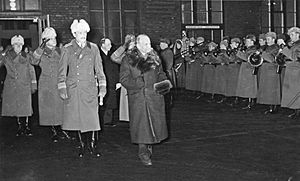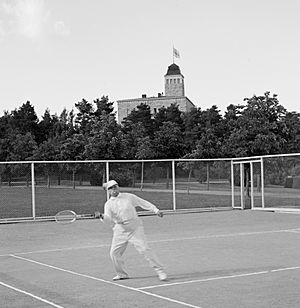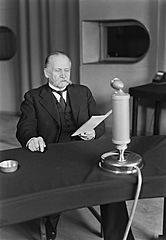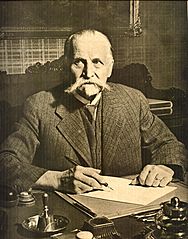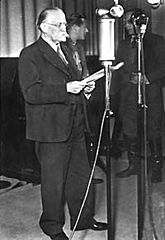Kyösti Kallio facts for kids
Quick facts for kids
Kyösti Kallio
|
|
|---|---|
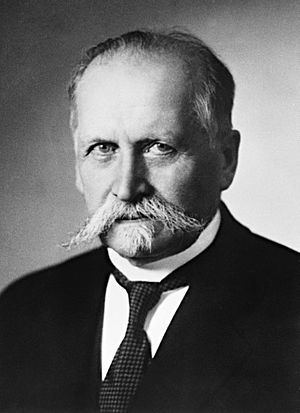
Kyösti Kallio in 1937
|
|
| 4th President of Finland | |
| In office 1 March 1937 – 19 December 1940 |
|
| Prime Minister | Aimo Cajander Risto Ryti |
| Preceded by | Pehr Evind Svinhufvud |
| Succeeded by | Risto Ryti |
| 8th Prime Minister of Finland | |
| In office 7 October 1936 – 15 February 1937 |
|
| President | Pehr Evind Svinhufvud |
| Preceded by | Toivo Mikael Kivimäki |
| Succeeded by | Aimo Cajander |
| In office 16 August 1929 – 4 July 1930 |
|
| President | Lauri Kristian Relander |
| Preceded by | Oskari Mantere |
| Succeeded by | Pehr Evind Svinhufvud |
| In office 31 December 1925 – 13 December 1926 |
|
| President | Lauri Kristian Relander |
| Preceded by | Antti Tulenheimo |
| Succeeded by | Väinö Tanner |
| In office 14 November 1922 – 18 January 1924 |
|
| President | Kaarlo Juho Ståhlberg |
| Preceded by | Aimo Cajander |
| Succeeded by | Aimo Cajander |
| Speaker of the Finnish Parliament | |
| In office 21 October 1930 – 8 October 1936 |
|
| Preceded by | Juho Sunila |
| Succeeded by | Väinö Hakkila |
| In office 1 February 1929 – 16 August 1929 |
|
| Preceded by | Paavo Virkkunen |
| Succeeded by | Paavo Virkkunen |
| In office 3 September 1927 – 31 January 1928 |
|
| Preceded by | Paavo Virkkunen |
| Succeeded by | Paavo Virkkunen |
| In office 2 May 1924 – 31 March 1925 |
|
| Preceded by | Paavo Virkkunen |
| Succeeded by | Wäinö Wuolijoki |
| In office 6 September 1922 – 14 November 1922 |
|
| Preceded by | Wäinö Wuolijoki |
| Succeeded by | Wäinö Wuolijoki |
| In office 8 May 1920 – 29 March 1921 |
|
| Preceded by | Lauri Kristian Relander |
| Succeeded by | Wäinö Wuolijoki |
| Personal details | |
| Born | 10 April 1873 Ylivieska, Grand Duchy of Finland, Russian Empire |
| Died | 19 December 1940 (aged 67) Helsinki, Finland |
| Political party | Agrarian |
| Spouse | Kaisa Nivala |
| Children | 6 |
| Occupation | Farmer Bank clerk |
| Signature | |
Kyösti Kallio (born April 10, 1873 – died December 19, 1940) was a very important Finnish politician. He was the fourth President of Finland from 1937 to 1940. During his time as president, he led Finland through a tough period called the Winter War.
Kallio was the first Finnish president to resign from his job. He was also the only president to die while still officially in office. He passed away from a heart attack right after he resigned, before his term officially ended.
Unlike other presidents, Kyösti Kallio did not go to university. He was a strong leader of the Agrarian League party. He served as Prime Minister four times and Speaker of the Parliament six times. He also worked as the Minister of Agriculture many times.
One of his biggest achievements was a law called "Lex Kallio" in 1922. This law helped farmers who didn't own land to buy their own farms. He was a candidate for president in 1931 and won the election in 1937.
Contents
Kyösti Kallio's Life and Career
Early Life and Education
Kyösti Kallio was born as Gustaf Kalliokangas in Ylivieska, which was part of the Grand Duchy of Finland. At that time, Finland was a region of the Russian Empire. His father, Mikko Kalliokangas, was a farmer and a local politician.
Kyösti went to school in Oulu. There, he met Santeri Alkio, who later became a key thinker for the Agrarian League.
Starting in Politics
Kallio began his political journey when Russia tried to make Finland more Russian. He joined the Young Finnish Party. From 1904 to 1906, he was a member of the Finnish Parliament, representing farmers.
In 1906, he joined the new Agrarian League party. He quickly became one of its most important leaders.
Finland Becomes Independent
In 1917, the Russian ruler, Tsar Nicholas II, was removed from power. This led to big changes in Finland. Kallio was part of a group of Finnish politicians who went to Russia to discuss Finland's future.
Their talks were successful. Finland was allowed to set up its own government, called the Senate. Kallio became the Minister of Agriculture in this new government. His main tasks were to help with farmer strikes and find enough food for the country during World War I.
Later, there was a disagreement about who had the most power in Finland. Kallio first supported giving power to the Finnish Parliament. However, he did not like how some politicians worked with Russian groups.
After another revolution in Russia, Finnish leaders decided that the Parliament should have the highest authority. On December 4, 1917, the Finnish government declared Finland independent. The next day, Kallio helped pass a resolution in Parliament to make this official.
Finnish Civil War
During the Civil War in Finland, Kallio had to hide in Helsinki. He was on the "White" side, which was against the "Red" side. After German troops helped the Whites win in Helsinki, Kallio became a voice for peace. He did not want revenge against the Reds.
Creating the Republic
In 1918, there was a big debate about whether Finland should be a kingdom or a republic. Kallio believed Finland should be a republic. He even resigned from the government because he supported a republic.
Eventually, the idea of a kingdom was dropped, and Finland became a republic. Kallio returned to the government and became prime minister. He focused on reforms in education, land, and settlement. His most famous achievement was "Lex Kallio" in 1922. This law helped the government buy land and sell it to farmers who didn't own land. This allowed many people to get their own small farms.
Supporting Prohibition
Kallio supported the law that banned alcohol in Finland. He was disappointed when this law was removed in 1932.
Becoming President
Kallio was elected president with the support of several parties. They wanted to make sure that the previous president, Pehr Evind Svinhufvud, was not re-elected. As president, Kallio believed in a parliamentary approach. This meant he let the Parliament and government make most decisions, rather than using his own personal power too much.
Before the Winter War began, Kallio convinced Marshal Mannerheim, a key military leader, to stay in his position. During the war, Kallio did not want to give up any land to the Soviet Union. But in 1940, he had to agree to sign the Moscow Peace Treaty, which meant Finland lost some territory.
After this, Kallio's health got worse. His right arm became paralyzed. He was not very active in the talks with Germany that led to the next war, the Continuation War. In August 1940, he had a serious stroke. Prime Minister Risto Ryti took over his duties.
Resignation and Death
Kyösti Kallio officially resigned on November 27, 1940. He planned to leave the capital city, Helsinki, and go back to his farm. On the evening of December 19, 1940, after a farewell ceremony, he collapsed and died at the Helsinki Central Railway Station. This happened while a band played a patriotic Finnish song.
Some stories say he died in the arms of Marshal Mannerheim. However, he actually died in the arms of his adjutant, Aladár Paasonen, and Colonel A. F. Airo.
Religious Beliefs
A very important part of Kyösti Kallio's life was his strong Christian faith. He learned this faith from his family. It became even deeper after he married Kaisa Nivala, who was also a very religious person.
Even though Kallio was often too busy for church, he prayed a lot when he faced difficult political decisions. He even wrote some of these prayers in his diary. He also read Christian books with his wife and discussed them in letters. Kallio often mentioned God in his speeches. During the Winter War, he asked Finns serving their country to read the Bible.
Before leaving the Presidential Palace for the last time, Kallio sang a hymn with his family.
Gallery
-
Kallio stepping out of his car; Marshal Mannerheim stands left from him.
Cabinets
- Kallio I Cabinet
- Kallio II Cabinet
- Kallio III Cabinet
- Kallio IV Cabinet
| Kyösti Kallio | |
|---|---|
 |
|
| Armiger | Kyösti Kallio |
Honours and Awards
Kyösti Kallio received many awards and decorations from Finland and other countries:
 Grand Cross of the Order of the White Rose (Finland)
Grand Cross of the Order of the White Rose (Finland) Grand Cross of the Order of the Cross of Liberty
Grand Cross of the Order of the Cross of Liberty Knight of the Order of the Seraphim (Sweden)
Knight of the Order of the Seraphim (Sweden) Order of the Polar Star (Sweden)
Order of the Polar Star (Sweden) Order of Falcon (Iceland)
Order of Falcon (Iceland) Collar of the Order of the White Star
Collar of the Order of the White Star Cross of Liberty Military Leadership (Estonia)
Cross of Liberty Military Leadership (Estonia) Cross of Liberty Civilian Service (Estonia)
Cross of Liberty Civilian Service (Estonia) Order of the Cross of the Eagle
Order of the Cross of the Eagle Order of the Estonian Red Cross
Order of the Estonian Red Cross Order of Three Stars (Latvia)
Order of Three Stars (Latvia) Order of Merit (Hungary)
Order of Merit (Hungary) Order of Polonia Restituta
Order of Polonia Restituta
See also
 In Spanish: Kyösti Kallio para niños
In Spanish: Kyösti Kallio para niños


